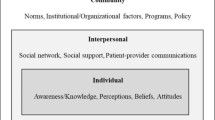Abstract
The study was conducted to investigate issues surrounding human papillomavirus (HPV) vaccine delivery in a multi-ethnic, multi-religious and multi-cultural society. A qualitative in-depth interview study was conducted with a sample of 20 physicians. Physicians described the success of HPV vaccines recommendation as very poor. Many expressed reluctance to offer the vaccine to preadolescents. The most notable barrier to vaccination was the vaccine’s high cost. Parents of eligible vaccinees were concerned about the efficacy and side effects of the new vaccine, while adult women have low risk perception for HPV infection. Promoters and inhibitors of HPV vaccination in our multi-ethnic, multi-religious and multi-cultural community were identified. This study suggests the need to strengthen the infrastructure necessary for HPV vaccine delivery and to specifically target poor underserved women.
Similar content being viewed by others
References
Ministry of Health Malaysia. (1999). Malaysia’s Health Technical Report of the Director-General of Health, Malaysia.
Social Statistics Bulletin. (2005). Malaysia 2005. Department of Statistics, Kuala Lumpur, Malaysia.
Nor Hayati, O. (2003). Cancer of the cervix-from bleak past to bright future: A review, with an emphasis on cancer of the cervix in Malaysia. Malaysian Journal of Medical Sciences, 10, 13–26.
Lim, G. C. C. (2003). Cancer in Malaysia—there is light at the end of the tunnel. The Medical journal of Malaysia, 58(5), 632–635.
Ministry of Health Malaysia (MOH). 1998. Annual reports of Ministry of Health, 1998.
Nor Hayati, O., & Ayob, M. C. (1997). Pap smear study: The squeal. Is there a need to change the sampling tool. The Malaysian journal of pathology, 19, 77. (Abstract).
Wong, L. P., Wong, Y. L., Low, W. Y., Khoo, E. M., & Shuib, R. (2008). Cervical cancer screening attitudes and beliefs of Malaysian women. International Journal of Behavioral Medicine, 15, 289–292.
Wong, L. P. (2009). Preventing cervical cancer through human papillomavirus vaccination: Perspective from focus groups. Journal of Lower Genital Tract Disease, 13(2), 85–93.
Wong, L. P. (2008). Young multiethnic women’s attitudes toward the HPV vaccine and HPV vaccination. International Journal of Gynecology and Obstetrics, 103(2), 131–135.
Sam, I. C., Wong, L. P., Rampal, S., et al. (2009). Maternal acceptance of human papilomavirus vaccine in Malaysia. Journal of Adolescent Health, 44, 610–612.
Vetter, K. M., & Geller, S. E. (2007). Moving forward: Human papillomavirus vaccination and prevention of cervical cancer. Journals of Womens Health, 16(9), 1258–1268.
Zimet, G. D., Nicole, L., Rosenthal, S. L., Lazcano-Ponce, E., & Allen, B. (2006). Psychosocial aspects of vaccine acceptability. Vaccine, 24(Suppl. 3), S201–S209.
Glaser, B. G., & Strauss, A. (1967). The discovery of grounded theory: Strategies for qualitative research. Chicago, IL: Aldine Publishing Co.
Strauss, A., & Corbin, J. (1998). Basics of qualitative research: Grounded theory, procedures and techniques. Newbury Park, CA: Sage.
Wong, L. P. (2009). Physicians’ experiences with HPV vaccine delivery: Evidence from developing country with multiethnic populations. Vaccine, 27, 1622–1627.
Dempsey, A. F., Zimet, G. D., Davis, R. L., & Koutsky, L. (2006). Factors that are associated with parental acceptance of human papillomavirus vaccines: A randomized intervention study of written information about HPV. Pediatrics, 117(5), 1486–1493.
Kane, M. A. (2006). Delivering HPV vaccine in the industrial and developing world: The role of the ob-gyn community. International Journal of Gynecology and Obstetrics, 94(Suppl 1), S89–S94.
Sussman, A. L., Helitzer, D., Sanders, M., Urquieta, B., Salvador, M., & Ndiaye, K. (2007). HPV and cervical cancer prevention counseling with younger adolescents: Implications for primary care. Annals of Family Medicine, 5(4), 298–304.
Daley, M. F., Liddon, N., Crane, L. A., et al. (2006). A national survey of pediatrician knowledge and attitudes regarding human papillomavirus vaccination. Pediatrics, 118, 2280–2289.
Riedesel, J. M., Rosenthal, S. L., Zimet, G. D., et al. (2005). Attitudes about human papillomavirus vaccine among family physicians. Journal of Pediatric and Adolescent Gynecology, 18(6), 391–398.
Lee, L. K., Chen, P. C. Y., Lee, K. K., & Kaur, J. (2006). Premarital sexual intercourse among adolescents in Malaysia: A cross-sectional Malaysian school survey. Singapore Medical Journal, 47(6), 476–481.
Jacob, M., Bradley, J., & Barone, M. A. (2005). Human papillomavirus vaccine: What does the future hold for preventing cervical cancer in resource-poor settings through immunization programs? Sexually Transmitted Diseases, 32, 635–640.
Sperber, N. R., Brewer, N. T., & Smith, J. S. (2008). Influence of parent characteristics and disease outcome framing on HPV vaccine acceptability among rural, Southern women. Cancer Causes and Control, 19(1), 115–118.
Wong, L. P. (2009). HPV information needs, educational educational message and channel of delivery preferences: Views from developing country with multiethnic population. Vaccine, 27, 1410–1415.
Harper, D. M., Franco, E. L., Wheeler, C., et al. (2004). Efficacy of a bivalent L1 virus-like particle vaccine in prevention of infection of human papillomavirus type 16 and 18 in young women: A randomised controlled trial. Lancet, 364, 1757–1765.
Diekema, D. S. (2005). American Academy of Pediatrics Committee on Bioethics. Responding to parental refusals of immunization of children. Pediatrics, 115(5), 1428–1431.
Economic Planning Unit (EPU). (2008). Mid-term review of the Ninth Malaysia Plan 2006-2010. Kuala Lumpur, Malaysia: Economic Planning Unit, Prime Minister’s Department.
Kirby, D. (2002). The impact of schools and school programs upon adolescent sexual behavior. Journal of sex research, 39, 27–33.
Acknowledgments
Financial support was provided through the University of Malaya Research Grant FR141/2007A. Special thanks to the physicians who participated in this study. Without their enthusiastic collaboration, this work would not have been possible.
Disclosure of Interests
The author declared no conflicts of interest.
Author information
Authors and Affiliations
Corresponding author
Rights and permissions
About this article
Cite this article
Wong, L.P. Issues Surrounding HPV Vaccine Delivery in a Multi-Ethnic Country in Asia: the Physician’s Perspective. J Community Health 36, 14–22 (2011). https://doi.org/10.1007/s10900-010-9275-0
Published:
Issue Date:
DOI: https://doi.org/10.1007/s10900-010-9275-0




